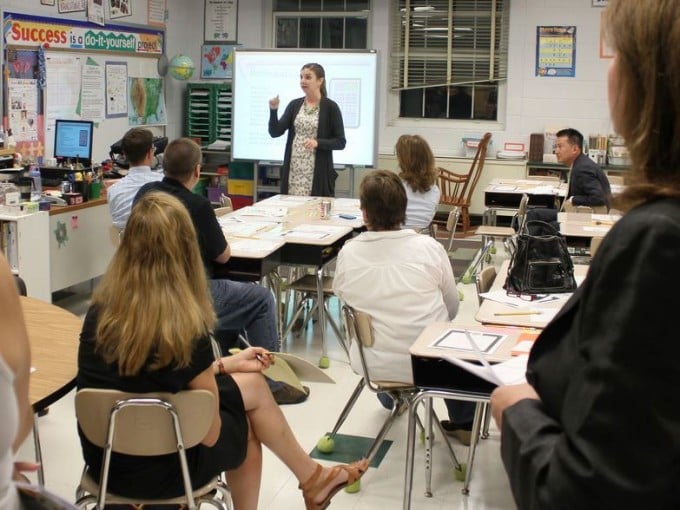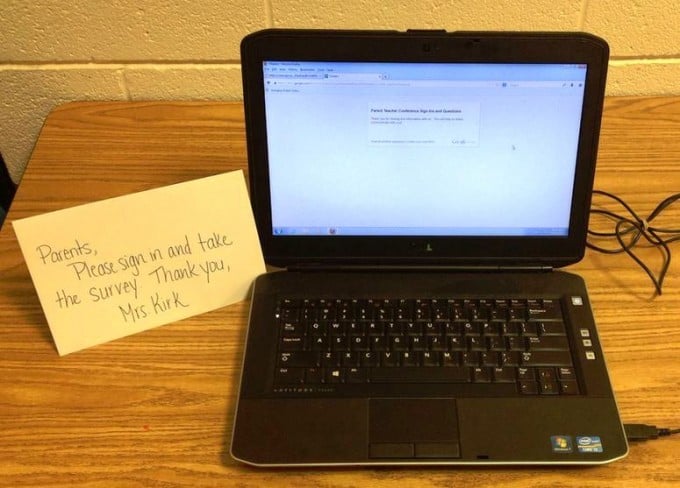Making the Most of Your Open House/Curriculum Night
Market: Education
On lists published by polling companies identifying our greatest fears, public speaking is often at or near the top. Teachers aren’t immune to that fear. Even though they spend every day in front of students, when parents come in for Open House/Curriculum Night, it can make for an unnerving evening.
“I am so nervous before Open House,” one elementary teacher confessed. “It’s so much easier to talk to students.” Even though she spends every day in front of students, this teacher still experiences the jitters when speaking to parents. Surprisingly, many parents feel the same way. One mother remarked, “I have three children and it’s really hard to get to every classroom. I always feel like I’m interrupting and am never sure I get all the information I need or that the teacher wants the parents to have.”
The good news is that teachers and parents alike have high expectations for events that allow them to interact. The better news is that there are ways to make those events a success for parents, for teachers and best of all, the children.
Hosting a successful Open House/Curriculum Night For School Administrators
 Communicate: Parents are bombarded with information from dozens of different sources. They get information from the school, from teams in which their children participate, from extracurricular activities other than sports, from clubs, friends, churches. The list goes on and on. One school administrator commented on the number of parents who miss Open House/Curriculum Night because the note was “in the bottom of the backpack” or information was not communicated adequately. Use social media, e-mail, notes home, school newsletters and any other communication device used by your school. Some schools even use text messages to send important information.
Communicate: Parents are bombarded with information from dozens of different sources. They get information from the school, from teams in which their children participate, from extracurricular activities other than sports, from clubs, friends, churches. The list goes on and on. One school administrator commented on the number of parents who miss Open House/Curriculum Night because the note was “in the bottom of the backpack” or information was not communicated adequately. Use social media, e-mail, notes home, school newsletters and any other communication device used by your school. Some schools even use text messages to send important information.
Make it Easy: Sometimes people are reluctant to come to a new place or a place that isn’t familiar. Be sure that parking lots and entrances are carefully marked and lighted. Make sure greeters welcome parents warmly and direct them to the correct classroom. Make sure signage is clear and easy to find. If necessary, post temporary signs. Offer hand-outs of the building layout. If parking is an issue, be sure to include parking information on all of the open house invitations.
For Teachers:
Get organized: Build an event plan; start with your goal and add in the supporting activities. Your presentation should answer the following questions:
- Who are you? Introduce yourself, how long you’ve been in teaching, what you love best about teaching and why you’re excited about the school year.
- What will happen? Give a brief overview of the event so people know what to listen for and why it matters.
- What? What is your class about? Are the subjects clear? What are the goals for the year? Provide information on skill-building, not just content. For example, tell parents about a project and the skills students will practice during the project (critical thinking, decision-making, collaboration, etc.). Describe situations where those skills will be useful, for both young people and adults. Parents, just like their children, need to understand the real-life application of all you work to convey.
- Where? How will you direct parents through the different areas of your classroom? How will they know what goes on in the Reading Nook? Why are the walls decorated the way they are?
- Why? The answer to this question is critical, as it will come from parents and students all year long. Why does this matter? Is this information important? Why does my child have homework? Think about and prepare for the “why” questions you are sure to receive.
How does the parent help?
When parents support your efforts in the classroom, students learn better. It also makes your job easier and much more enjoyable. Be specific about how parents can reinforce learning at home.

Photo Credit: Woodleywonderworks on Flicker
Engage: You have a goal; you have a plan. Now, connect with the parents. Greet people at the front door, shake hands and make it clear you’re glad to see them. Introduce yourself and direct them into the classroom. Make sure you have enough adult-size seats in the room. This is your opportunity to begin building these crucial relationships.
Follow Up: Send parents home with the information they can use at home to support the learning that takes place in the classroom. Again, be specific. Parents don’t automatically know the best tactics for helping their children. Be absolutely certain any written information is error-free and well-written. You just spent a good deal of time demonstrating your competence to the parents of your students. A badly edited document can quickly undo your efforts. You might even follow up with a quick e-mail thanks to the parents who attended.
Above all, make it clear to the parents that you value their children, believe in them and want them to be successful. Your enthusiasm for your work is contagious. Showing how much you care will go a long way in making them your allies in learning.
More Quick Tips:
- Make sure you have water to drink. One teacher remembers, “I was shocked at how dry my mouth got. Between doing a lot of talking and being a little nervous, I was parched.”
- Set up activities for parents. A simple scavenger hunt is a fun way to get them moving around the room to see what you’re working on. Or, do some sort of getting to know you ice-breaker game. Parents new to a school, in particular, want to meet other parents.
Offering Mom and Dad a quick anecdote about their child is a wonderful rapport-builder. Everyone enjoys feeling their child is unique and memorable.
